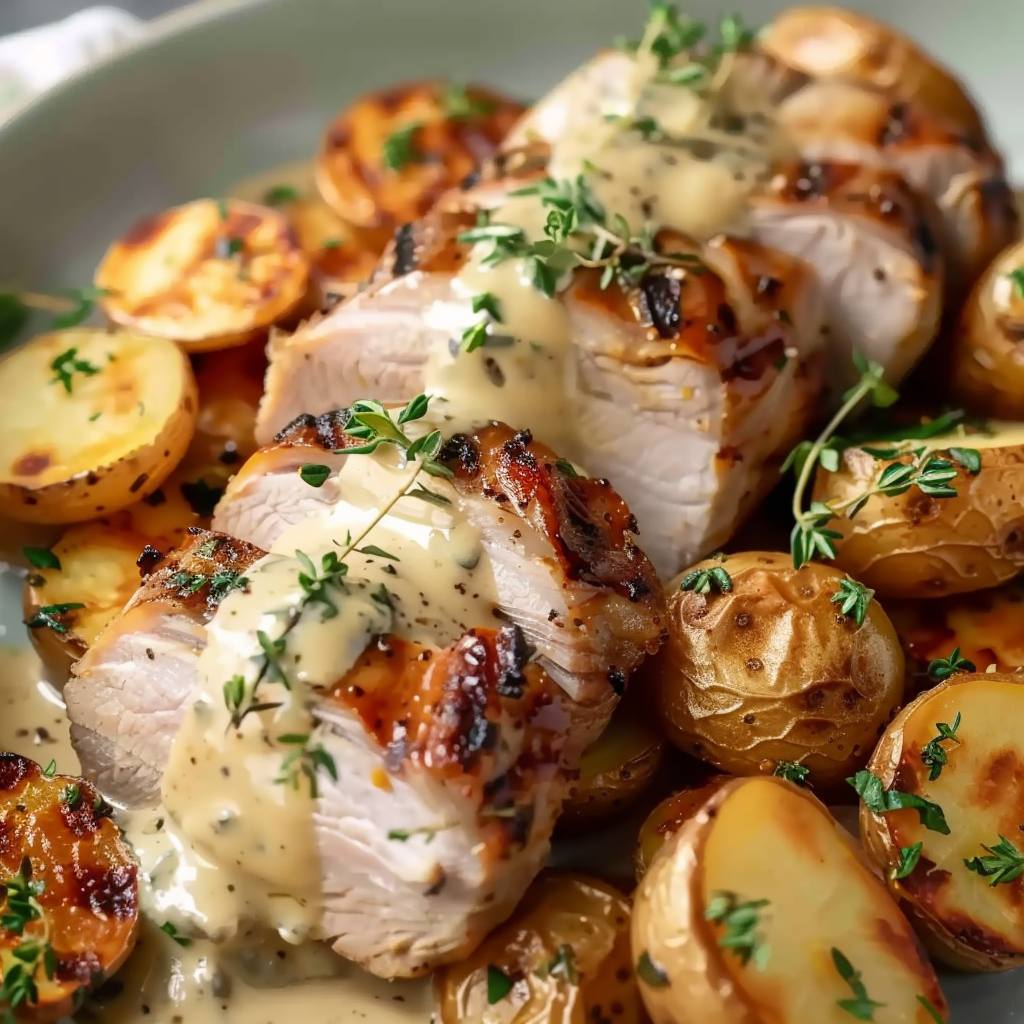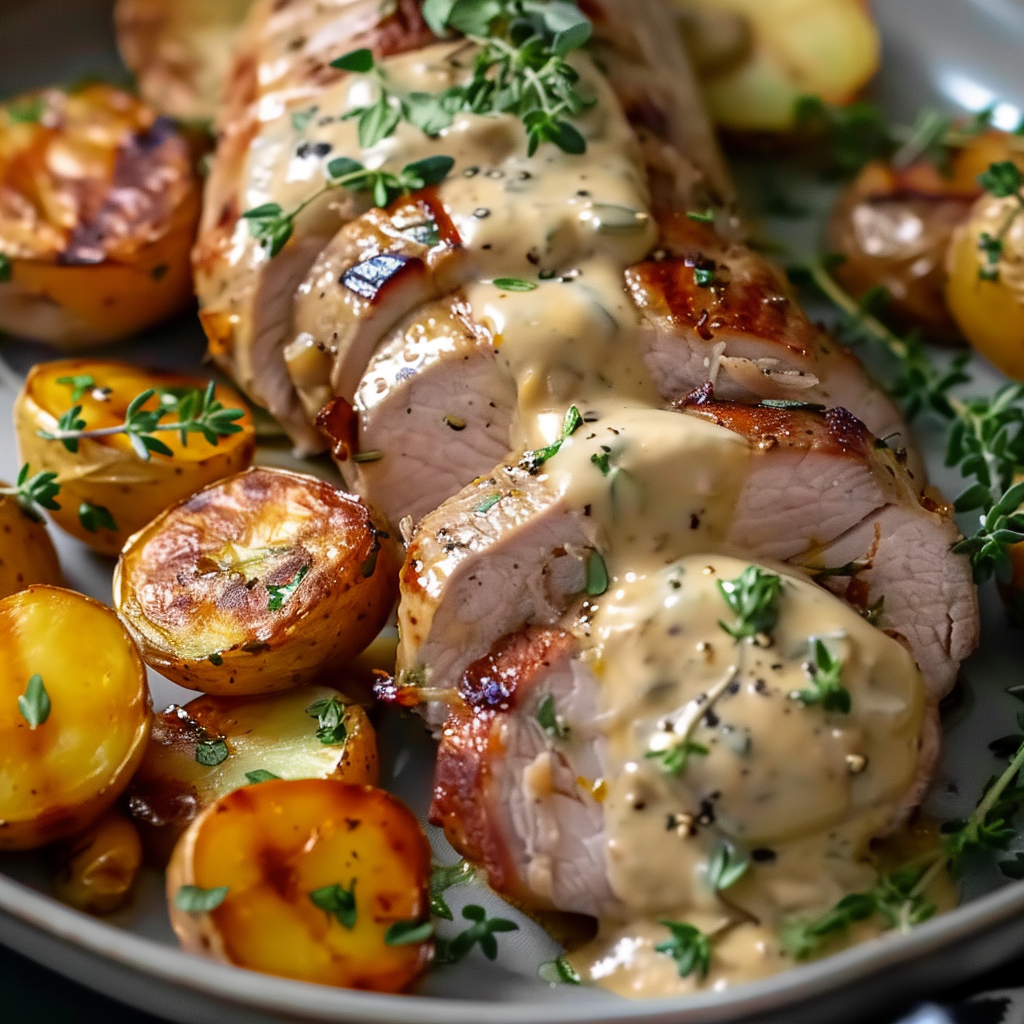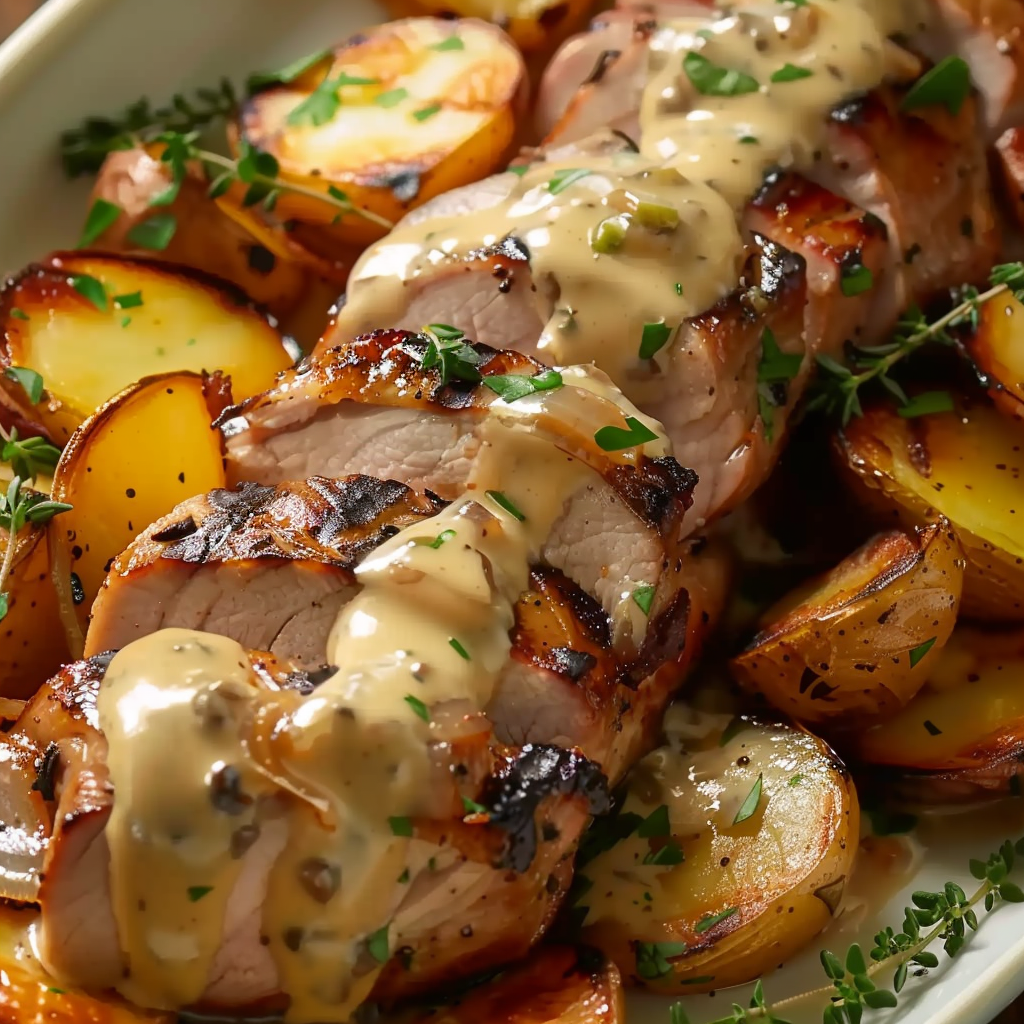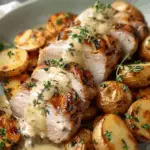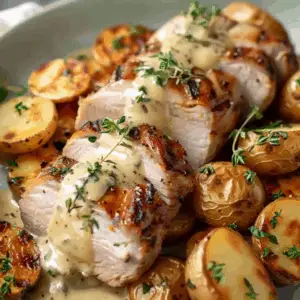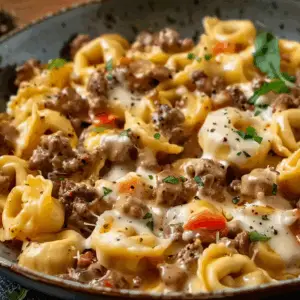If you’re looking for a flavorful yet simple roasted dinner, this pork tenderloin with maple mustard glaze is a must-try. Pork tenderloin is known for being a lean, tender cut of meat that cooks quickly and pairs well with both sweet and savory flavors. The combination of maple syrup and Dijon mustard creates a perfectly balanced glaze—sweet, tangy, and slightly sharp—bringing out the best in the pork.
What makes this dish a standout is not only the taste but also how easy it is to prepare. You don’t need complex techniques or hours in the kitchen. In fact, this recipe comes together with just a few ingredients and a single oven-safe skillet, making it a favorite for weeknights or casual gatherings. It’s also a great introduction to oven roasting, a method that enhances flavor and texture without much effort. Learn more about the science of oven roasting to better understand why this technique works so well.
The glaze made with maple syrup, aged mustard or Dijon mustard, and fresh thyme forms a flavorful crust on the pork, helping seal in moisture. This ensures that every slice is tender and juicy. For more background on what makes Dijon mustard such a versatile ingredient in savory dishes, visit this resource. The result is a beautifully browned pork tenderloin with a glistening, caramelized finish that’s satisfying yet elegant.
To round out the meal, consider pairing it with roasted root vegetables or a hearty lentil salad for a healthy balance. You can find presentation inspiration and plating ideas by exploring this Pinterest board for oven roasted pork tenderloin recipes, which offers visual guides for garnishes, side dishes, and serving styles. Whether you’re hosting guests or just craving a home-cooked meal, this dish delivers both taste and presentation with minimal effort.
Why Pork Tenderloin Works Well with Maple Mustard
Pork tenderloin is a naturally lean and mild-tasting cut, making it a blank canvas for bold and flavorful glazes. When paired with a maple mustard glaze, the tenderloin transforms into a savory-sweet centerpiece that’s both elegant and satisfying. The subtle sweetness of maple syrup balances beautifully with the sharp tang of Dijon mustard, creating a rich depth of flavor that enhances the pork without overpowering it.
This pairing isn’t just delicious—it also makes sense from a culinary standpoint. The sugar in maple syrup promotes caramelization, helping to develop a golden-brown crust during roasting. Learn more about how caramelization works here. That crust doesn’t just look appetizing; it locks in moisture, ensuring that each slice of pork remains juicy and flavorful.
The Dijon mustard, originating from France’s Burgundy region, adds a zesty complexity that cuts through the richness of the meat. If you’re curious about the origins and culinary uses of this ingredient, take a look at the Wikipedia page on Dijon mustard. Combined with a touch of fresh thyme, this glaze offers a sophisticated yet accessible flavor profile that complements pork exceptionally well.
In addition to taste, this pairing also works well for quick and efficient cooking. Pork tenderloin is one of the fastest-cooking cuts, typically requiring under 25 minutes in the oven. That makes it ideal for a weeknight dinner or when you’re short on time but still want a high-quality, satisfying meal. For added inspiration, explore this Pinterest post on easy pork tenderloin dinner to see how others elevate this classic dish.
Another advantage of this recipe is how well it pairs with side dishes, especially those that also play with sweet and savory flavors. From roasted carrots to mashed sweet potatoes, the options are as flexible as they are flavorful. You can even serve it cold the next day with a grain salad, like quinoa or farro, for a refreshing lunch.
Whether you’re aiming for something simple or more elevated, the combination of pork tenderloin and maple mustard glaze delivers a reliable and delicious result every time.
Ingredients Breakdown
Creating a flavorful oven roasted pork tenderloin with maple mustard glaze begins with choosing the right ingredients. Each element plays a vital role in building the dish’s signature balance of savory, sweet, and herbaceous flavors. Below is a breakdown of the essential ingredients and how they contribute to the overall dish.
For the Pork Tenderloin
-
Pork Tenderloin: This cut is lean, tender, and cooks quickly, making it ideal for roasting. It’s important to distinguish pork tenderloin from pork loin, as they differ in thickness, texture, and cook time. You can learn more about this cut from this article.
-
Olive Oil: Used for searing, it adds richness and helps create a golden crust. More about its cooking uses can be found on the olive oil Wikipedia page.
-
Salt and Pepper: Essential for seasoning, they enhance the natural flavors of the pork and allow the glaze to shine without being overpowered.
-
Dijon Mustard: This aged mustard provides a sharp, slightly spicy undertone that contrasts perfectly with the sweetness of the maple syrup. Its emulsifying properties also help the glaze adhere to the pork during roasting.
-
Maple Syrup: Pure maple syrup adds depth and sweetness, and assists in forming a beautifully caramelized glaze. Discover the history and varieties of maple syrup here.
-
Fresh Thyme: Brings an earthy, aromatic element that ties together the glaze’s components. Thyme complements both sweet and savory notes, making it a versatile herb in roasted dishes.
For the Melting Onions (Optional but Highly Recommended)
-
Yellow Onions: When slowly cooked, these onions become deeply sweet and soft, serving as a luxurious topping for the pork.
-
Butter & Olive Oil: The combination adds richness and aids in proper caramelization, a slow cooking process that draws out the onion’s natural sugars. More details about this cooking technique are available on this page.
-
Salt & Sugar: Accelerate the caramelization process and balance the onions’ sharpness.
-
Beef Broth: Deglazes the pan and intensifies the flavor of the onions, adding a savory element that complements the pork.
You can explore visual ingredient layouts and preparation inspiration on this Pinterest board for maple mustard glazed pork, where home cooks share their plating ideas and ingredient swaps.
This blend of ingredients makes for a harmonious dish that’s as pleasing to the eye as it is to the palate. With simple pantry staples and a few fresh additions, the dish feels both gourmet and approachable.
Step-by-Step Cooking Instructions (Detailed Walkthrough)
Preparing the Pork
Cooking pork tenderloin with maple mustard glaze involves a few straightforward steps that ensure tenderness and flavor in every bite. Begin by preheating your oven to 400°F (200°C). This temperature allows for even oven roasting while giving the glaze time to caramelize on the surface of the meat. Pat the pork tenderloin dry with paper towels to remove excess moisture—this step is essential for achieving a perfect sear. Season the pork generously with salt and black pepper.
In a heavy, oven-safe skillet, heat a tablespoon of olive oil over medium-high heat. When the oil begins to shimmer, place the pork tenderloin into the pan. Sear each side for 2–3 minutes until golden brown. Searing is key—it locks in the pork’s natural juices and helps form a crust that will later absorb the glaze. For a deeper understanding of why olive oil is ideal for searing and roasting, check this Wikipedia article about olive oil for cooking.
Next, brush the top of the pork with Dijon mustard and drizzle it lightly with maple syrup. Sprinkle with fresh thyme leaves to infuse herbal fragrance during roasting. The combination of maple syrup and mustard creates a glaze that caramelizes beautifully in the oven. You can view presentation ideas and serving visuals from this Pinterest post on healthy pork dinner ideas to enhance your plating. Transfer the skillet to the preheated oven and roast for 10–12 minutes, or until the internal temperature reaches 145°F (63°C). This ensures the meat remains juicy and slightly pink in the center.
Once cooked, remove the skillet from the oven and allow the pork to rest for at least five minutes before slicing. Resting is a crucial step—it lets the juices redistribute throughout the meat, maintaining moisture and tenderness. You can learn more about this method by visiting the Wikipedia entry on oven roasting. While the pork rests, it’s time to make the melting onions, which add a layer of sweetness and depth that pairs perfectly with the savory glaze.
Making the Melting Onions
In a separate skillet, heat butter and olive oil over medium heat. Once melted, add thinly sliced yellow onions, followed by a pinch of salt and sugar. Stir occasionally and cook slowly for about 20 minutes, allowing the onions to soften and turn golden brown. The process of caramelization deepens their flavor, providing a delicate sweetness that balances the tanginess of the mustard glaze. For more insight into how caramelization works, refer to this Wikipedia page.
When the onions are soft and richly golden, pour in a small amount of beef broth to deglaze the pan, scraping up any browned bits. Simmer for an additional three to five minutes until the broth reduces and the onions become silky. You can find more plating and onion-garnish inspiration from this Pinterest post on oven roasted pork tenderloin.
To serve, slice the roasted pork tenderloin into medallions and top each piece with a spoonful of melting onions. The resulting dish combines sweet, tangy, and savory flavors with a moist, tender texture. For more details about this specific meat cut, refer to this pork tenderloin guide. The final presentation is elegant yet comforting—perfect for a weekday dinner or a special occasion meal.
Tips for Perfect Oven Roasted Pork Tenderloin
Roasting pork tenderloin to perfection requires attention to a few key details. By following these expert tips, you can achieve a juicy, flavorful dish every time—whether you’re preparing it for a casual meal or a more formal gathering.
-
Use a Meat Thermometer
The most reliable way to avoid overcooked pork is by using a meat thermometer. Insert it into the thickest part of the tenderloin, avoiding the pan. For ideal results, aim for an internal temperature of 145°F (63°C), then allow the meat to rest. This rest period lets juices redistribute, keeping the pork tender and moist. For additional insight into oven temperatures and heat retention, refer to the Wikipedia page on ovens. -
Don’t Skip the Sear
Searing before roasting is essential for two reasons: it locks in moisture and builds flavor. The golden crust created during searing acts as a barrier, helping the meat stay juicy during the high heat of the oven. -
Season Generously
Pork is a mild meat that benefits from assertive seasoning. Don’t be shy with the salt, pepper, and any herbs you’re using—particularly thyme or rosemary, which both complement the flavors of maple syrup and Dijon mustard beautifully. -
Let It Rest Before Slicing
Allowing the pork to rest for at least 5–10 minutes after roasting is non-negotiable. This step helps retain juices and ensures that every slice remains moist. Cutting too early can result in dry meat, even if it was cooked perfectly. -
Apply the Glaze at the Right Time
Brush the glaze on just before roasting—not too early, as the sugars in maple syrup can burn. If you want a thicker crust, consider glazing once before roasting and again during the final few minutes of cook time. -
Avoid Overcooking
Pork tenderloin is a lean cut and can dry out quickly. Keeping a close eye on internal temperature and pulling it from the oven promptly is key. Remember, it continues to cook slightly as it rests. -
Try a Cast Iron Skillet
For even cooking and a better sear, use a cast iron or heavy oven-safe skillet. These pans retain and distribute heat efficiently, which is perfect for dishes requiring both stove-top searing and oven roasting.
For a visual guide and recipe variations, check out this helpful Pinterest post on maple mustard glazed pork. You’ll find step-by-step photos and plating suggestions to bring your pork tenderloin dish to life.
These small but impactful techniques will elevate your pork from simple to exceptional—making this dish one of the most reliable and rewarding recipes in your kitchen rotation.
Substitutions and Variations
One of the best things about this pork tenderloin with maple mustard glaze is how adaptable it is. Whether you’re catering to specific dietary needs or simply working with what you have in your kitchen, there are several smart substitutions and delicious variations that still deliver amazing results.
-
Mustard Options
If Dijon mustard isn’t available, you can substitute it with whole grain mustard, which adds a lovely texture to the glaze. For a spicier profile, try spicy brown mustard. Avoid yellow mustard—it’s too tangy and can overpower the glaze’s sweetness. Curious about the history and flavor profile of Dijon? See more here. -
Sweetener Swaps
Maple syrup gives a rich, woodsy sweetness, but if you’re out, honey is a fantastic alternative. It’s a bit thicker and slightly floral, but still balances well with mustard. Avoid using artificial syrups—they lack the depth of real maple and can burn during roasting. -
Alternative Cuts
While pork tenderloin is ideal for its tenderness and quick cook time, pork loin can be used if properly adjusted. Loin is thicker and denser, so increase the cooking time and use a thermometer to avoid drying it out. Learn more about the pork tenderloin cut here. -
Make It with Beef
Want a richer, red-meat alternative? This glaze pairs excellently with beef tenderloin medallions. Simply follow the same instructions but adjust cooking time for your preferred doneness. Get inspired by plating ideas from this Pinterest post on healthy pork dinner ideas. -
Herb Adjustments
Fresh thyme is recommended, but rosemary or even sage can be used for a more earthy flavor profile. Dried herbs work in a pinch—just reduce the quantity to avoid overpowering the dish. -
Add a Crunch Element
For a gourmet finish, top the roasted pork with crushed toasted pecans or walnuts mixed into the melting onions. The nuttiness pairs beautifully with the sweet glaze.
These variations allow you to customize this recipe to your taste or based on what’s already in your pantry—making it not just delicious, but also versatile and reliable for all kinds of meals.
Best Side Dishes to Serve With Maple Mustard Pork Tenderloin
Pairing the right sides with this maple mustard pork tenderloin enhances the entire meal, creating a balanced plate that’s both comforting and elegant. Here are some standout accompaniments that match the flavor and texture of the dish:
-
Roasted Vegetables
Carrots, Brussels sprouts, parsnips, and sweet potatoes are excellent choices. Their natural sweetness intensifies during roasting, complementing the glaze. A light drizzle of olive oil and thyme ties the flavors together. -
Lentil Salad
A warm lentil salad adds protein and earthiness to the meal. Toss cooked lentils with arugula, cherry tomatoes, and a lemon vinaigrette for contrast. Explore this Pinterest pin for ideas on healthy sides. -
Mashed Potatoes or Sweet Potato Purée
Creamy mashed potatoes balance the tanginess of the mustard and provide a neutral base. For a sweeter option, go with whipped sweet potatoes finished with a hint of nutmeg. -
Quinoa or Couscous
Light and fluffy grains like quinoa or couscous are perfect for soaking up extra glaze and onion juices. Add a few chopped herbs or dried fruits to tie the dish together. -
Crisp Green Salad
A simple salad with a mustard vinaigrette offers acidity that balances the richness of the pork and onions. Use baby greens, radishes, and a few shavings of Parmesan for a fresh, sharp bite. -
Grilled Asparagus or Broccolini
These green veggies provide crunch and bitterness that contrast well with the pork’s sweetness.
Creating a plate with color, texture, and balanced flavors elevates this already impressive main dish and turns it into a complete, satisfying meal.
Storing and Reheating Leftovers
Storing and reheating leftover pork tenderloin with maple mustard glaze is simple and allows you to enjoy the dish over several meals without losing flavor or texture.
-
Storage:
Store sliced pork in an airtight container with any remaining glaze and melting onions. Keep refrigerated for up to 3 days. If freezing, wrap tightly in foil or plastic and place in a freezer-safe bag for up to 2 months. -
Reheating:
For best results, reheat slices in a skillet over low heat with a splash of broth or water to keep the pork moist. You can also use a microwave, covering the pork with a damp paper towel and heating in 30-second intervals.
These simple steps help preserve the pork’s tenderness and keep the glaze from drying out, so every bite remains flavorful.
Nutrition Information (Approximate)
This dish is not just delicious—it’s also nutrient-dense and a smart choice for balanced eating. Below is an approximate breakdown per serving (based on a 6 oz pork portion with glaze and onions):
-
Calories: 360
-
Protein: 38g
-
Carbohydrates: 14g (from maple syrup and onions)
-
Fat: 16g
-
Sugar: 10g
-
Sodium: 540mg
-
Fiber: 1g
Pork tenderloin is considered one of the leanest cuts of pork, high in protein and low in fat, making it an excellent choice for health-conscious meals. The addition of maple syrup adds a touch of sugar, but when paired with high-fiber sides like lentils or vegetables, it balances out into a wholesome dish. For more info on the nutritional qualities of pork, explore this Wikipedia resource.
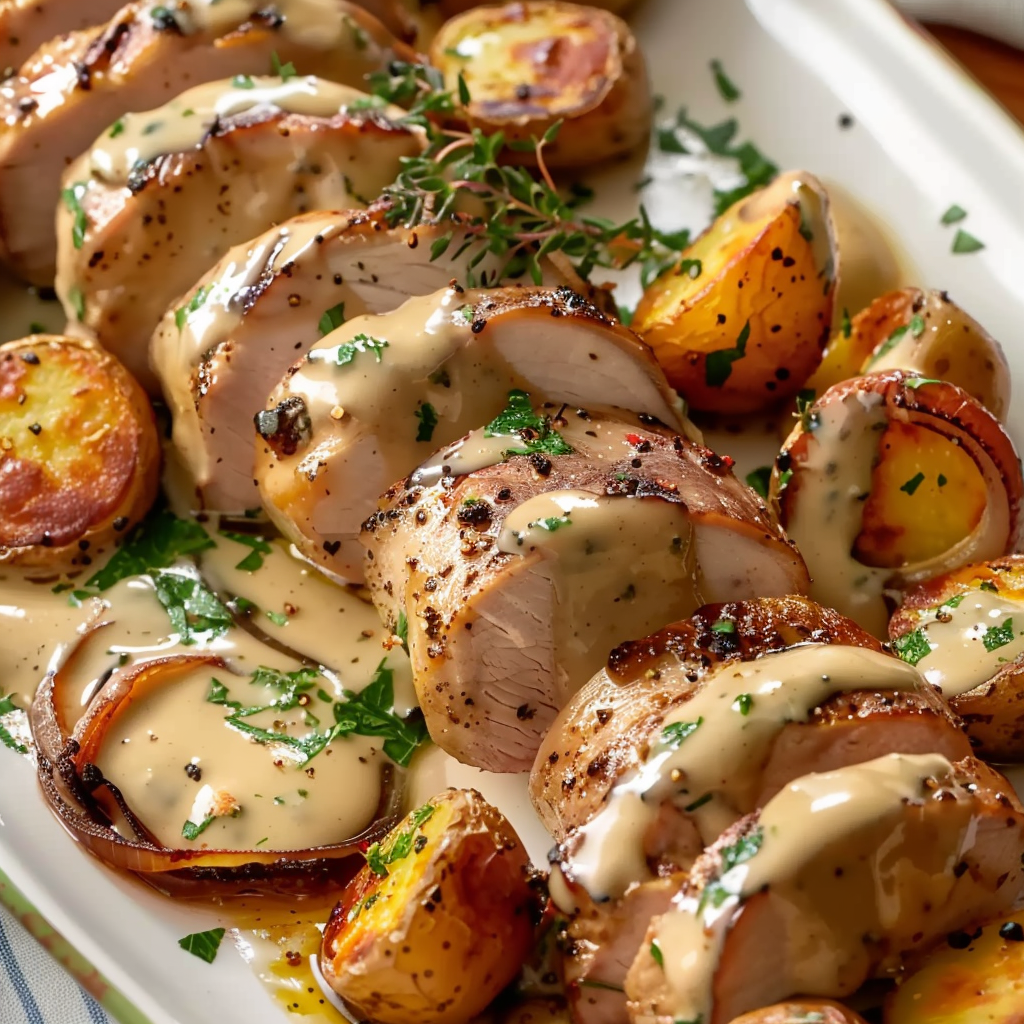
Common Cooking Questions (FAQ Section)
Can I use pork loin instead of pork tenderloin?
Yes, but adjust for the longer cooking time. Pork loin is larger and denser, so use a meat thermometer and aim for 145°F internally. Slicing it thinly after resting helps retain tenderness.
How long should I cook pork tenderloin in the oven?
Typically, 10–12 minutes at 400°F (after searing) is sufficient. Always use a thermometer to ensure doneness without overcooking.
What’s the best internal temperature for pork tenderloin?
145°F is ideal, followed by a 5–10 minute rest. The pork will be slightly pink in the center but completely safe to eat, according to USDA guidelines.
Can I make the glaze ahead of time?
Absolutely. You can mix the glaze (mustard, maple syrup, thyme) up to 3 days ahead and store it in the fridge. Just bring it to room temperature before using.
How do I know if the pork is cooked through?
Use a meat thermometer. The texture should be firm but slightly yielding, and juices should run clear or lightly pink.
Can this recipe be cooked in an air fryer?
Yes! Sear the pork first if your air fryer doesn’t support high heat. Then cook at 375°F for 12–15 minutes, checking the internal temperature.
Is it okay to use yellow mustard instead of Dijon?
It’s not ideal. Yellow mustard has a sharper vinegar flavor and lacks the depth of Dijon. If needed, mix yellow with a little honey or olive oil to mellow it out.
Pork Tenderloin with Maple Mustard Glaze: An Easy Roasted Dinner
Tender, oven-roasted pork tenderloin is glazed with a sweet and tangy blend of maple syrup, Dijon mustard, and thyme, then topped with soft, caramelized onions simmered in beef broth. This comforting yet elegant dish is simple to prepare, packed with flavor, and perfect for weeknights or dinner parties.
- Author: Clara
Ingredients
For the beef:
- 2 beef tenderloin mignons (about 6 oz each)
- Salt and pepper, to taste
- 1 tablespoon olive oil
- 2 tablespoons aged mustard (or Dijon mustard)
- 1 teaspoon fresh thyme leaves (or ½ tsp dried)
For the melting onions:
- 2 large yellow onions, thinly sliced
- 2 tablespoons butter
- 1 tablespoon olive oil
- ½ teaspoon salt
- ½ teaspoon sugar
- ¼ cup beef broth
Instructions
- Preheat oven to 400°F (200°C).
- Pat the beef tenderloin mignons dry with paper towels and season both sides generously with salt and pepper.
- In an oven-safe skillet over medium-high heat, add olive oil. Sear the beef on both sides until browned, about 2-3 minutes per side.
- Remove from heat. Brush the tops of the beef with aged mustard and sprinkle with thyme.
- Transfer the skillet to the oven and roast for 10-12 minutes, or until the internal temperature reaches your desired doneness. Remove from oven and let rest for 5 minutes.
- While the beef is roasting, prepare the onions. In a separate skillet, heat butter and olive oil over medium heat. Add sliced onions, salt, and sugar. Cook, stirring often, until onions are golden and caramelized, about 20 minutes.
- Add beef broth to the onions and simmer for another 3-5 minutes, until the liquid has mostly reduced and the onions are soft and flavorful.
- Serve the beef tenderloin mignons topped with the melting onions. Optionally garnish with extra thyme.
Notes
-
Use a meat thermometer to prevent overcooking.
-
Let pork rest before slicing for the juiciest results.
-
Glaze can be made in advance and stored in the refrigerator.
-
Onions can be prepared up to 2 days ahead and reheated before serving.
-
Try pairing with roasted vegetables or a lentil salad for a complete meal.
-
For an alternate twist, substitute pork with beef tenderloin medallions.
